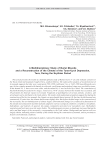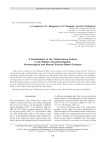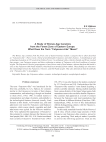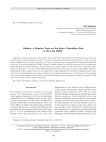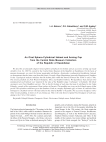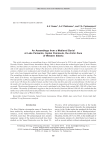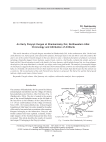The metal ages and medieval period. Рубрика в журнале - Archaeology, Ethnology & Anthropology of Eurasia
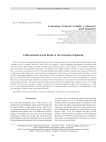
A monumental horse burial in the Armenian highlands
Статья
Here we report on the unprecedented discovery of the complete skeleton of a ritually interred adult stallion with a bronze ring in its mouth. The horse was buried in a unique 15-meters diameter monumental stone-built tomb excavated in the Aghavnatun necropolis located on the southern slopes of Mt. Aragats, in the northern fringes of the Ararat Depression, Republic of Armenia. The tumulus was roughly circular; the horse’s remains were found in situ, in an inner oval-shaped structure. Our methodological procedure included a detailed description of the burial, a taphonomic study of the bones, and meticulous morphometric observations and measurements, and thus we could provide a taxonomic defi nition and an age estimate. Direct radiometric dating of the horse’s skeleton provided a date of 2130±20 BP. The morphological characteristics of the horse, with its tall stature and slender feet, suggest that it was a large individual, similar to the extinct breed of Nisean horse previously known mainly from textual and iconographical sources. The metal ring found in the mouth of the horse suggests that it likely served as a breeding stallion. This discovery presents a unique combination of zooarchaeological evidence for the importance of the horse in the Parthian-Hellenistic worlds, and advances our understanding of the broad social signifi cance of the past breeding of equids in the Armenian Highlands.
Бесплатно
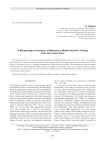
A morphological analysis of Malyshevo middle Neolithic pottery from the Lower Amur
Статья обзорная
Бесплатно

Статья
This article presents a description of Khankarinsky Dol mound 34 on the left bank of the Inya River, 1–1.5 km southeast of Chineta, Krasnoshchekovsky District, Altai Territory. Excavations revealed a cist with a supine burial of a male, whose head was oriented to the east. Beyond the eastern wall of the cist, a horse cranium and three crania of sheep were placed. Features of the burial rite suggest that the burial belongs to the Korgantass type, which is distributed over the Altai-Sayan and Kazakhstan, with certain parallels in northern China. Principal categories of offerings are analyzed, including those associated with the horse. On their basis, the horse harness is reconstructed. On the basis of the typology of artifacts and radiocarbon analysis, the burial was dated to the 5th to 4th centuries BC (possibly late 5th to early 4th centuries BC). The Korgantass burials at Khankarinsky Dol and elsewhere in the Altai Mountains indicate a migration from the eastern part of the nomadic world, apparently from northern China or the Trans-Baikal region.
Бесплатно
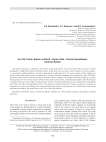
A runic inscription at Kalbak-Tash II, Central Altai, with reference to the location of the AZ tribe
Статья обзорная
Бесплатно
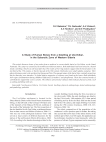
A study of human bones from a dwelling at Ust-Voikar, in the subarctic zone of Western Siberia
Статья обзорная
Бесплатно

Статья научная
We describe a large fragment of fabric from the under-headdress excavated from mound 51 at Yaloman II—a site on a high terrace near the place where the Bolshoy Yaloman fl ows into the Katun, Central Altai. Various criteria, including radiocarbon analysis, suggest that the burial dates to the Xiongnu Age (200 BC to 100 AD). The structure of the textile was assessed microscopically. On the basis of morphological criteria, the fi bers were identifi ed as silk. The fabric is described according to the accepted international standards. Results attest to the use of a treadle loom for producing polychrome silk fabric, from which the early nomads sewed a headdress in the form of a cap or bonnet. Such a prestigious material was produced in limited quantities in China to decorate details of clothing worn by the elite. Decorative silk items could have been imported from there to the Altai as gifts received by the leader of the nomadic Xiongnu Empire in Inner Asia. The Altai was part of this empire, as demonstrated by the entire assemblage of funerary items from Yaloman II.
Бесплатно
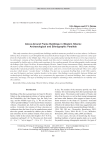
Above-ground frame buildings in Western Siberia: archaeological and ethnographic parallels
Статья
Бесплатно
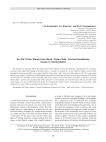
An Old Turkic statue from Borili, Ulytau hills, Central Kazakhstan: issues in interpretation
Статья научная
We describe an unusual Old Turkic statue at Borili (Ulytau, Central Kazakhstan), distinguished by a peculiar position of hands and by an unusual object-a pickaxe held instead of a vessel. Stylistic features and possible prototypes among actual pickaxes suggest that the statue dates to 7th to early 8th centuries AD. The composition attests to the sculptor's familiarity with Sogdian/Iranian art and with that of China. Several interpretations of the statue are possible. The standard version regarding Old Turkic statues erected near stone enclosures is that they represent divine chiefs-patrons of the respective group. Certain details carved on the statue indicate an early origin of the image. It is also possible that such statues are semantically similar to those of guardians placed along the 'path of the spirits" near tombs of Chinese royal elite members.
Бесплатно
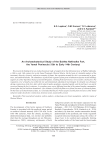
Статья научная
We present the findings from an archaeobotanical study of samples from the habitation layer of Bukhta Nakhodka, a 13th to early 14th century fort on the Yamal Peninsula, Western Siberia. On the basis of a detailed analysis of the taxonomic diversity of macro- and micro-remains of plants, the vegetation around the site is reconstructed as grass, moss, and subshrub tundra. The abundance of pollen and vegetative plant parts in habitation deposits inside buildings support an earlier hypothesis that peat and turf briquettes, resulting from turf removal, were used for construction. The vegetation cover of tundra area within the site and immediately adjoining it had changed. Its integrity was disrupted during construction of the fort, after which ruderal tundra apophytes expanded rapidly, and the turf layer was partly recovered during the fort's existence. A secondary grass cover, differing from that of the natural tundra communities, formed after the fort had been abandoned. A few remains of wild food plants were found, but none of cultivated plants. On the basis of archaeobotanical data, it is concluded that the pre-Nenets people used the plant resources of the Yamal subarctic tundra mostly for construction, domestic needs, and possibly as food.
Бесплатно
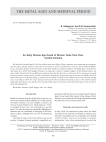
An early Bronze Age hoard of bronze tools from Dvin, Central Armenia
Статья научная
We describe a hoard found in 2018 on a hilltop near the village of Dvin, Armenia, and comprising seven daggers and six adzes. Similar pickaxes and adzes were found in caches at Dzhrashen, Yerevan, and at Nahal-Mishmar, Israel. A peculiar feature of the Dvin adzes is that their blades are sharply rounded, resembling those of the Bronze Age battle axes. All the Dvin daggers belong to a single type, similar to tangless daggers of the Maikop culture, but more robust. Results of an X-ray diffraction analysis show that the Yerevan, as well as the Dvin, specimens are made of arsenic bronze, whose source is hard to determine. Judging by the typology and the presence of blanks, the Dvin hoard indicates local metalworking, a production of artisans working in the southern part of the Alaverdy mining area. According to GPS, the direct distance between the Dvin and Yerevan hoards is just 13 km. Both locations apparently belonged to one and the same metalworking region in Armenia, and both hoards date to the late 5th to early 4th millennia BC.
Бесплатно


